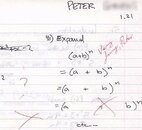You are using an out of date browser. It may not display this or other websites correctly.
You should upgrade or use an alternative browser.
You should upgrade or use an alternative browser.
Fundies Math
- Thread starter Jasonmh
- Start date
Please register or login
Welcome to ScubaBoard, the world's largest scuba diving community. Registration is not required to read the forums, but we encourage you to join. Joining has its benefits and enables you to participate in the discussions.
Benefits of registering include
- Ability to post and comment on topics and discussions.
- A Free photo gallery to share your dive photos with the world.
- You can make this box go away
Now we're hacking, old school
just for the nerds...
An astrophysicist, and physicist, and a mathematician are taking a vacation by train through the Scottish countryside.
The astrophysicist sees a black sheep standing on a hill and blurts out
The physicist quickly corrects him
The mathematician finally declares
The astrophysicist sees a black sheep standing on a hill and blurts out
All sheep are black!!!
The physicist quickly corrects him
All sheep in Scotland are black!!!
The mathematician finally declares
There exists at least one sheep in Scotland, of which, at least one side is black!!!
There's a really good reason I went to music school. 2+2=.. shoot, where's my calculator?
MonkSeal
Contributor
BTW easy and usable diving math can be found at Peter's site:
http://www.dir-diver.com/en/knowledge/calculations_on_the_fly.html
http://www.dir-diver.com/en/knowledge/dive_planning_on_the_fly.html
http://www.dir-diver.com/en/knowledge/average_depth.html
http://www.dir-diver.com/en/knowledge/calculations_on_the_fly.html
http://www.dir-diver.com/en/knowledge/dive_planning_on_the_fly.html
http://www.dir-diver.com/en/knowledge/average_depth.html
Charlie99
Contributor
- Messages
- 7,966
- Reaction score
- 169
- # of dives
- 500 - 999
Amascuba and I are really saying the same thing. He just breaks the problem down into a series of problems, with the solution of each being obvious.do it easy:That's too much math for me! How about (700/3000)*80 then divide that by (8*4)?
The first part is how much gas he used in cft, and the second part is how he used it. I like Charlie's method better- breaking it down to the pieces you actually use for the answer you are looking for.
Same basic concept. It's better to truly understand than to simply memorize.
Charlie99
Contributor
- Messages
- 7,966
- Reaction score
- 169
- # of dives
- 500 - 999
A very simple example of dimensional analysis that only involves length would be a conversion from 1.2 mile to xxxx centimeters.Rick Inman:-What??? Dim-who-sional whatzitmacaliit???
You just setup the equation as
1.2 miles * 5280 ft/mile * 12 inches/ft * 2.54cm/inch = ______ cm.
When you go through and match up units in the dividends and the divisors, the miles, feet, and inches should all cancel out, leaving only the cm. If it doesn't work out that way, then you haven't set up the equation right.
Dimensional analysis is just the fancy way of saying "when you cancel out units, you ought to have the right ones left over".
====================
Dimensional analysis can often provide some nice insights.
For example, it is easy to show that the real units of SAC aren't cfm or lpm, but instead are truly cu ft per minute per ata. It just happens that at 1ata the last part drops out. If you include the /ata at the end you can easily see for example that
1 cu ft/min/1ata = 2 cu ft/min/2ata.
lamont:what TSandM said.
dimensional analysis r3wl3z
You just like your l33t sp34k.
lamont
Contributor
amascuba:You just like your l33t sp34k.
3y3 \/\/i11 pwn j00!!!
lamont:3y3 \/\/i11 pwn j00!!!
p0wn4g3 w00t!
Ah, reminds me of one of my favorites...do it easy:Now we're hacking, old school
just for the nerds...
An astrophysicist, and physicist, and a mathematician are taking a vacation by train through the Scottish countryside.
The astrophysicist sees a black sheep standing on a hill and blurts outAll sheep are black!!!
The physicist quickly corrects himAll sheep in Scotland are black!!!
The mathematician finally declaresThere exists at least one sheep in Scotland, of which, at least one side is black!!!
A mathematician and an engineer agreed to take part in a psychological test. They sat on one side of a room and waited not knowing what to expect. A door opened on the other side and a scantily-clad woman came in the room and stood on the far side. They were then instructed that every time they heard a beep they could move half the remaining distance to the woman. They heard a beep and the engineer jumped up and moved halfway across the room while the mathematician continued to sit, looking disgusted and bored. When the mathematician didn't move after the second beep he was asked why. "Because I know I will never reach the woman." The engineer was asked why he chose to move and replied, "Because I know that very soon I will be close enough for all practical purposes!"
Similar threads
Question
Air consumption, is mine good?
- Replies
- 26
- Views
- 2,639
- Replies
- 1
- Views
- 744





